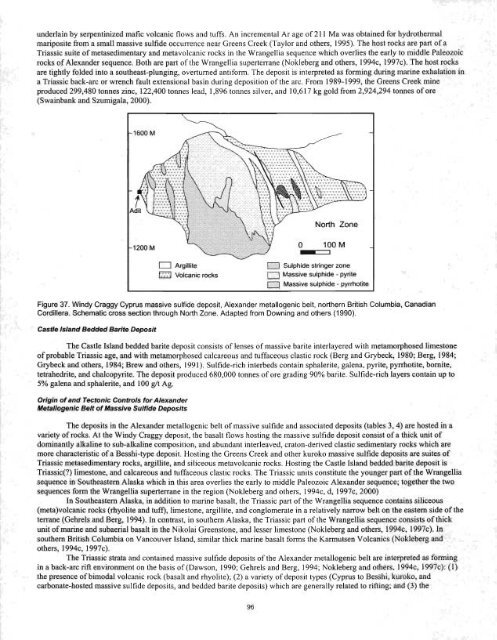Metallogenesis and Tectonics of the Russian Far East, Alaska, and ...
Metallogenesis and Tectonics of the Russian Far East, Alaska, and ...
Metallogenesis and Tectonics of the Russian Far East, Alaska, and ...
You also want an ePaper? Increase the reach of your titles
YUMPU automatically turns print PDFs into web optimized ePapers that Google loves.
underlain by serpentinized mafic volcanic flows <strong>and</strong> tuffs. An incremental Ar age <strong>of</strong> 2 1 1 Ma was obtained for hydro<strong>the</strong>rmal<br />
mariposite from a small massive sulfide occurrence near Greens Creek (Taylor <strong>and</strong> o<strong>the</strong>rs, 1995). The host rocks are part <strong>of</strong> a<br />
Triassic suite <strong>of</strong> metasedimentary <strong>and</strong> metavolcanic rocks in <strong>the</strong> Wrangellia sequence which overlies <strong>the</strong> early to middle Paleozoic<br />
rocks <strong>of</strong> Alex<strong>and</strong>er sequence. Both are part <strong>of</strong> <strong>the</strong> Wrangellia superterrane (Nokleberg <strong>and</strong> o<strong>the</strong>rs, 1994c, 1997~). The host roc<br />
are tightly folded into a sou<strong>the</strong>ast-plunging, overturned antiform. The deposit is interpreted as forming during marine exhalati<br />
a Triassic back-arc or wrench fault extensional basin during deposition <strong>of</strong> <strong>the</strong> arc. From 1989-1999, <strong>the</strong> Greens Creek mine<br />
produced 299,480 tonnes zinc, 122,400 tonnes lead, 1,896 tonnes silver, <strong>and</strong> 10,617 kg gold from 2,924,294 tonnes <strong>of</strong> ore<br />
(Swainbank <strong>and</strong> Szumigala, 2000).<br />
Volcanic rocks<br />
Figure 37. Windy Craggy Cyprus massive sulfide deposit, Alex<strong>and</strong>er metallogenic belt, nor<strong>the</strong>rn British Columbia, Canadian<br />
Cordillera. Schematic cross section through North Zone. Adapted from Downing <strong>and</strong> o<strong>the</strong>rs (1990).<br />
Castle Isl<strong>and</strong> Bedded Barite Deposit<br />
The Castle Isl<strong>and</strong> bedded barite deposit consists <strong>of</strong> lenses <strong>of</strong> massive barite interlayered with metamorphosed limestone<br />
<strong>of</strong> probable Triassic age, <strong>and</strong> with metamorphosed calcareous <strong>and</strong> tuffaceous clastic rock (Berg <strong>and</strong> Grybeck, 1980; Berg, 1984;<br />
Grybeck <strong>and</strong> o<strong>the</strong>rs, 1984; Brew <strong>and</strong> o<strong>the</strong>rs, 1991). Sulfide-rich interbeds contain sphalerite, galena, pyrite, pyrrhotite, bornite,<br />
tetrahedrite, <strong>and</strong> chalcopyrite. The deposit produced 680,000 tonnes <strong>of</strong> ore grading 90% barite. Sulfide-rich layers contain up to<br />
5% galena <strong>and</strong> sphalerite, <strong>and</strong> 100 g/t Ag.<br />
Origin <strong>of</strong> <strong>and</strong> Tectonic Controls for Alex<strong>and</strong>er<br />
Metallogenic Belt <strong>of</strong> Massive Sulfide Deposits<br />
The deposits in <strong>the</strong> Alex<strong>and</strong>er metallogenic belt <strong>of</strong> massive sulfide <strong>and</strong> associated deposits (tables 3,4) are hosted in a<br />
variety <strong>of</strong> rocks. At <strong>the</strong> Windy Craggy deposit, <strong>the</strong> basalt flows hosting <strong>the</strong> massive sulfide deposit consist <strong>of</strong> a thick unit <strong>of</strong><br />
dominantly alkaline to sub-alkaline composition, <strong>and</strong> abundant interleaved, craton-derived clastic sedimentary rocks which are<br />
more characteristic <strong>of</strong> a Besshi-type deposit. Hosting <strong>the</strong> Greens Creek <strong>and</strong> o<strong>the</strong>r kuroko massive sulfide deposits are suites <strong>of</strong><br />
Triassic metasedimentary rocks, arglllite, <strong>and</strong> siliceous metavolcanic rocks. Hosting <strong>the</strong> Castle Isl<strong>and</strong> bedded barite deposit is<br />
Triassic(?) limestone, <strong>and</strong> calcareous <strong>and</strong> tuffaceous clastic rocks. The Triassic units constitute <strong>the</strong> younger part <strong>of</strong> <strong>the</strong> Wrangellia<br />
sequence in Sou<strong>the</strong>astern <strong>Alaska</strong> which in this area overlies <strong>the</strong> early to middle Paleozoic Alex<strong>and</strong>er sequence; toge<strong>the</strong>r <strong>the</strong> two<br />
sequences form <strong>the</strong> Wrangellia superterrane in <strong>the</strong> region (Nokleberg <strong>and</strong> o<strong>the</strong>rs, 1994c, d, 1997c, 2000)<br />
In Sou<strong>the</strong>astern <strong>Alaska</strong>, in addition to marine basalt, <strong>the</strong> Triassic part <strong>of</strong> <strong>the</strong> Wrangellia sequence contains siliceous<br />
(meta)volcanic rocks (rhyolite <strong>and</strong> tuff), limestone, argillite, <strong>and</strong> conglomerate in a relatively narrow belt on <strong>the</strong> eastern side <strong>of</strong> <strong>the</strong><br />
terrane (Gehrels <strong>and</strong> Berg, 1994). In contrast, in sou<strong>the</strong>rn <strong>Alaska</strong>, <strong>the</strong> Triassic part <strong>of</strong> <strong>the</strong> Wrangellia sequence consists <strong>of</strong> thick<br />
unit <strong>of</strong> marine <strong>and</strong> subaerial basalt in <strong>the</strong> Nikolai Greenstone, <strong>and</strong> lesser limestone (Nokleberg <strong>and</strong> o<strong>the</strong>rs, 1994c, 1997~). In<br />
sou<strong>the</strong>rn British Columbia on Vancouver Isl<strong>and</strong>, similar thick marine basalt forms <strong>the</strong> Karmutsen Volcanics (Nokleberg <strong>and</strong><br />
o<strong>the</strong>rs, 1994c, 1997~).<br />
The Triassic strata <strong>and</strong> contained massive sulfide deposits <strong>of</strong> <strong>the</strong> Alex<strong>and</strong>er metallogenic belt are interpreted as forming<br />
in a back-arc rift environment on <strong>the</strong> basis <strong>of</strong> (Dawson, 1990; Gehrels <strong>and</strong> Berg, 1994; Nokleberg <strong>and</strong> o<strong>the</strong>rs, 1994c, 1997~): (I)<br />
<strong>the</strong> presence <strong>of</strong> bimodal volcanic rock (basalt <strong>and</strong> rhyolite); (2) a variety <strong>of</strong> deposit types (Cyprus to Besshi, kuroko, <strong>and</strong><br />
carbonate-hosted massive sulfide deposits, <strong>and</strong> bedded barite deposits) which are generally related to rifting; <strong>and</strong> (3) <strong>the</strong>
















